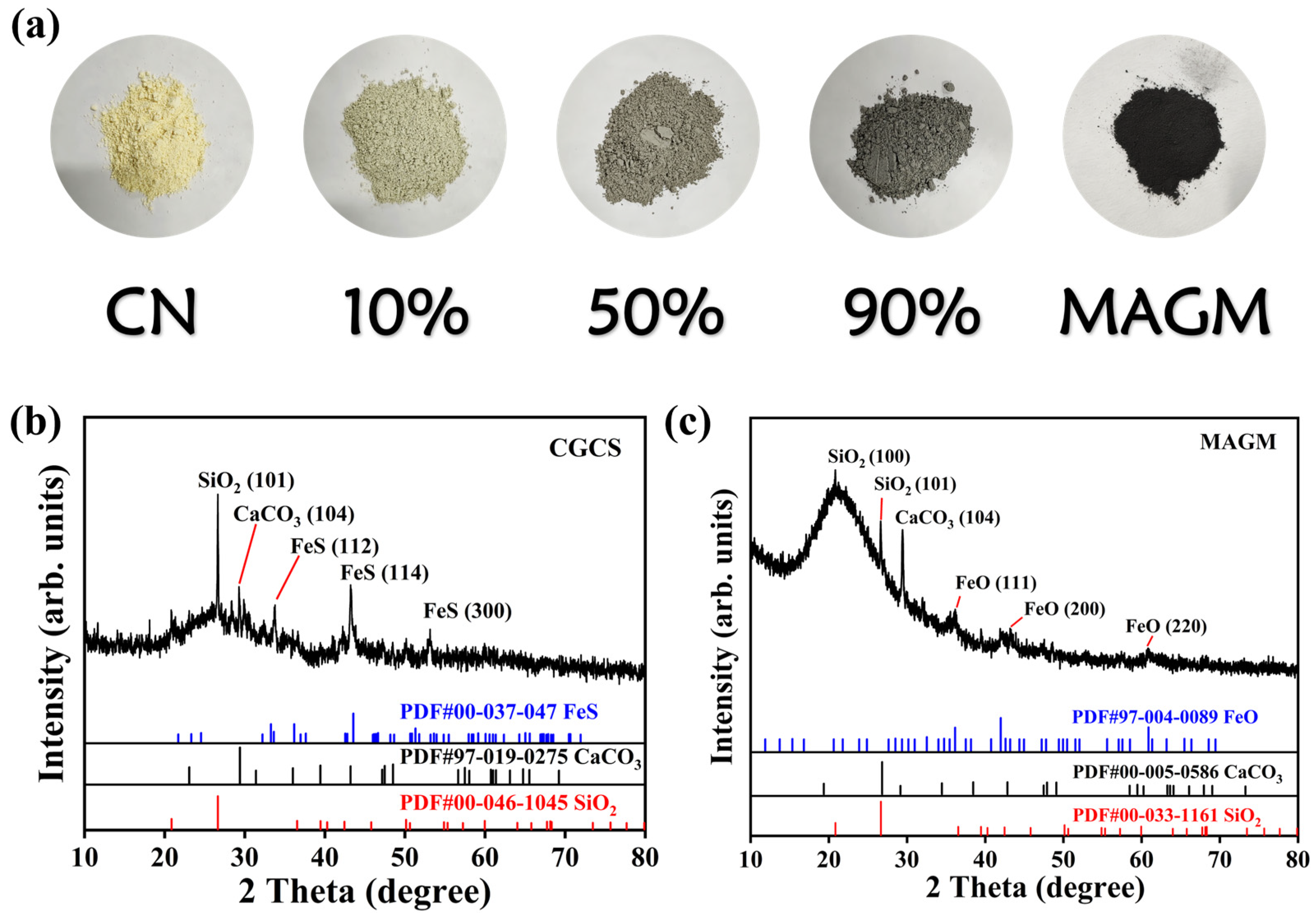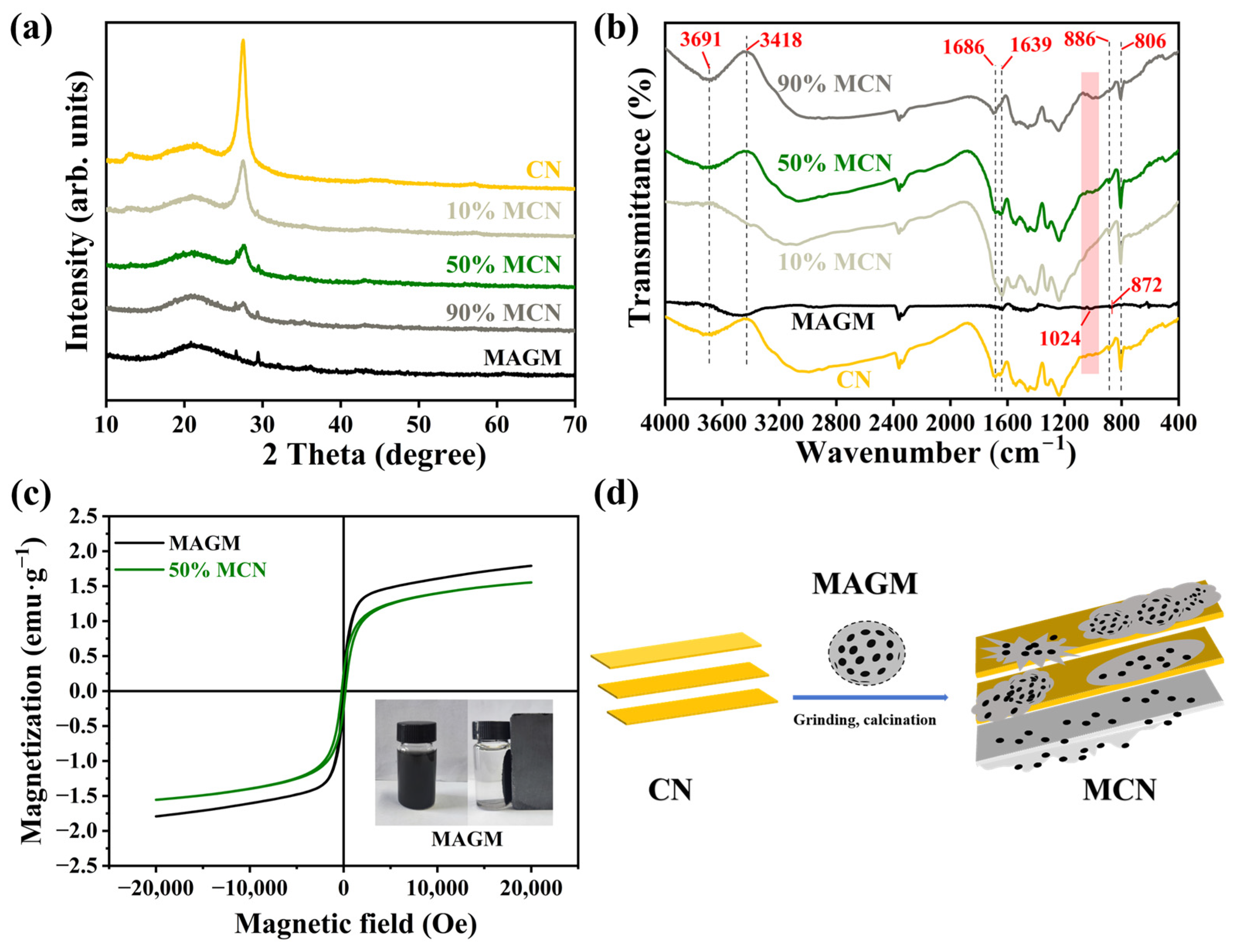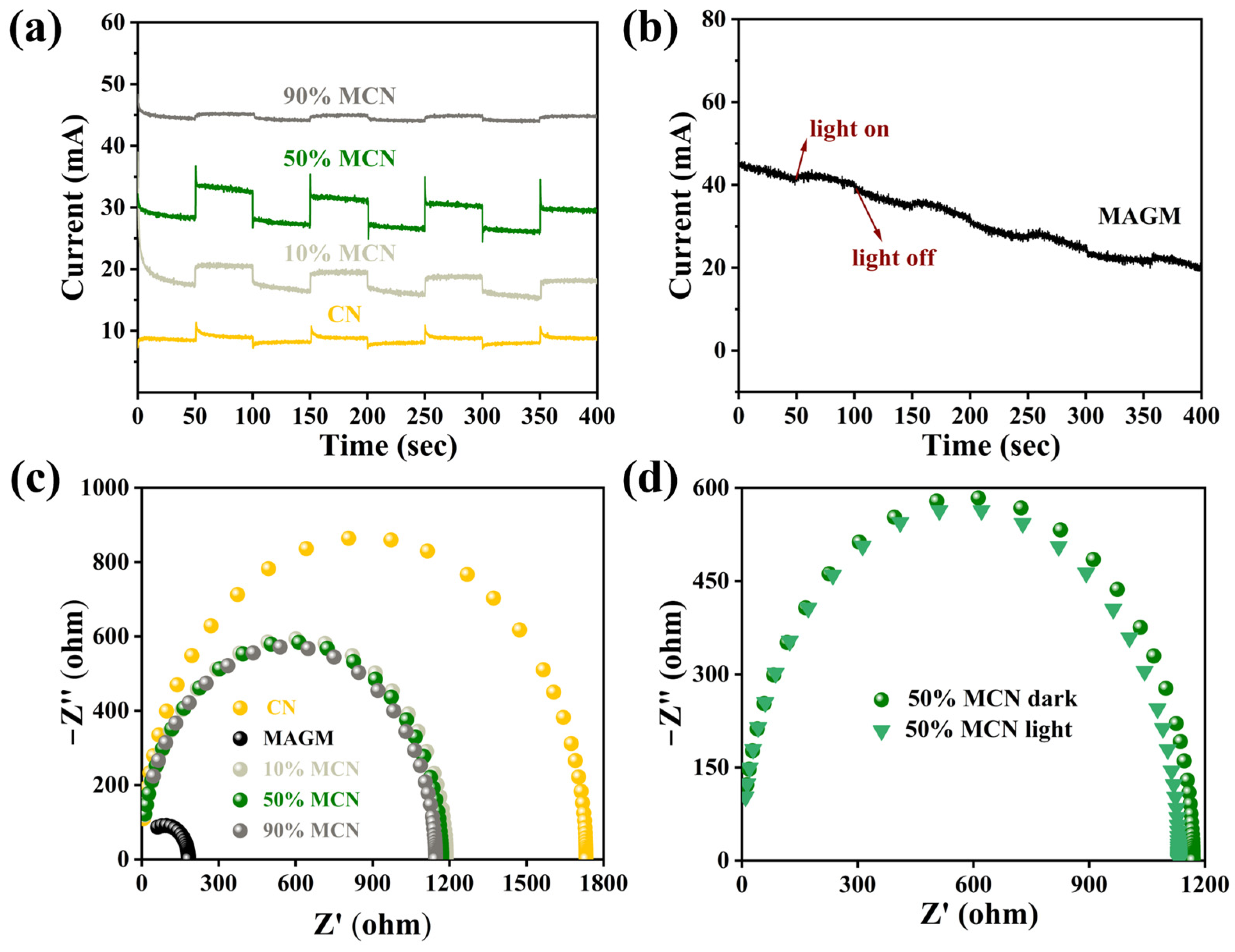Magnetic Coal Gasification Slag/Graphite Phase Carbon Nitride Composites for Photocatalytic Degradation of Tetracycline
Abstract
:1. Introduction
2. Materials and Methods
2.1. Experimental Apparatus and Reagents
2.2. Preparation of MAGM
2.3. Preparation of MCN
2.4. Experimental Degradation of Tetracycline by MCN
3. Results and Discussion
3.1. Structure and Morphology Analysis
3.2. Degradation Performance of Tetracycline by MCN
3.3. Photoelectric Properties of MCN
3.4. Mechanism of TC Degradation by MCN
3.5. Cycling Performance of MCN in TC Degradation
4. Conclusions
- (1)
- Under visible light irradiation, the 50% MCN composite photocatalyst has a good degradation rate of simulated tetracycline solution, the dark reaction adsorption degradation rate can reach 15%, and the light reaction degradation rate can reach 82%, and it has a magnetic recovery effect. The reason is that after the composite of MAGM and CN, the specific surface area is effectively increased by three times, and the active sites of photocatalytic reaction are increased. The impedance of MAGM is low, the ability to transport electrons is enhanced, and the transient photocurrent intensity of the composite is higher than that of ordinary carbon nitride, which has a low rate of photogenerated electron and hole complexation.
- (2)
- After cyclic degradation of tetracycline five times, the activity of 50% MCN only decreased by 14%, and the structure did not change. The magnetic separation of 50% MCN in solution was still achieved within 30 s, and the overall catalyst recovery was above 95%. In this study, the performance and cost of the catalysts were optimised by cleverly exploiting the characteristics of solid wastes, and the idea of “unconventional material design” provides a new paradigm for the development of environmentally functional materials.
Supplementary Materials
Author Contributions
Funding
Data Availability Statement
Conflicts of Interest
References
- Bielen, A.; Šimatović, A.; Kosić-Vukšić, J.; Senta, I.; Ahel, M.; Babić, S.; Jurina, T.; Plaza, J.J.G.; Milaković, M.; Udiković-Kolić, N. Negative environmental impacts of antibiotic-contaminated effluents from pharmaceutical industries. Water Res. 2017, 126, 79–87. [Google Scholar] [CrossRef] [PubMed]
- Wang, J.T.; Cai, Y.L.; Liu, X.J.; Zhang, X.D.; Cai, F.Y.; Cao, H.L.; Zhong, Z.; Li, Y.F.; Lü, J. Unveiling the visible-light-driven photodegradation pathway and products toxicity of tetracycline in the system of Pt/BiVO4 nanosheets. J. Hazard. Mater. 2022, 424, 127596. [Google Scholar] [CrossRef]
- Zainab, S.M.; Junaid, M.; Xu, N.; Malik, R.N. Antibiotics and antibiotic resistant genes (ARGs) in groundwater: A global review on dissemination, sources, interactions, environmental and human health risks. Water Res. 2020, 187, 116455. [Google Scholar] [CrossRef] [PubMed]
- Qin, K.; Wei, L.L.; Li, J.J.; Lai, B.; Zhu, F.Y.; Yu, H.; Zhao, Q.L.; Wang, K. A review of ARGs in WWTPs: Sources, stressors and elimination. Chin. Chem. Lett. 2020, 31, 2603–2613. [Google Scholar] [CrossRef]
- Han, Y.; Yang, L.; Chen, Y.; Cai, Y.; Shen, G. Removal of veterinary antibiotics from swine wastewater using anaerobic and aerobic biodegradation. Sci. Total Environ. 2019, 709, 136094. [Google Scholar] [CrossRef]
- Mangla, D.; Sharma, A.; Ikram, S. Critical review on adsorptive removal of antibiotics: Present situation, challenges and future perspective. J. Hazard. Mater. 2022, 425, 127946. [Google Scholar] [CrossRef] [PubMed]
- Ai, Y.J.; Liu, Y.; Huo, Y.Z.; Zhao, C.F.; Sun, L.; Han, B.; Cao, X.R.; Wang, X.K. Insights into the adsorption mechanism and dynamic behavior of tetracycline antibiotics on reduced graphene oxide (RGO) and graphene oxide (GO) materials. Environ. Sci. Nano 2019, 6, 3336–3348. [Google Scholar] [CrossRef]
- Wang, Y.; He, Y.; Li, X.; Nagarajan, D.; Chang, J.S. Enhanced biodegradation of chlortetracycline via a microalgae-bacteria consortium. Bioresour. Technol. 2022, 343, 126149. [Google Scholar] [CrossRef]
- Shao, S.; Wu, X. Microbial degradation of tetracycline in the aquatic environment: A review. Crit. Rev. Biotechnol. 2020, 40, 1010–1018. [Google Scholar] [CrossRef]
- Liu, R.; Zhang, C.J.; Liu, R.J.; Sun, Y.; Ren, B.Q.; Tong, Y.H.; Tao, Y. Advancing antibiotic detection and degradation: Recent innovations in graphitic carbon nitride (g-C3N4) applications. J. Environ. Sci. 2025, 150, 657–675. [Google Scholar] [CrossRef]
- Yuan, A.; Lei, H.; Xi, F.N.; Liu, J.Y.; Qin, L.; Chen, Z.; Dong, X.P. Graphene quantum dots decorated graphitic carbon nitride nanorods for photocatalytic removal of antibiotics. J. Colloid Interface Sci. 2019, 548, 56–65. [Google Scholar] [CrossRef] [PubMed]
- Zhao, Z.W.; Sun, Y.J.; Dong, F. Graphitic carbon nitride based nanocomposites: A review. Nanoscale 2015, 7, 15–37. [Google Scholar] [CrossRef]
- Verma, A.; Sharma, G.; Wang, T.; Kumar, A.; Dhiman, P.; García-Peñas, A. Graphitic carbon nitride (g-C3N4)-based magnetic photocatalysts for removal of antibiotics. Carbon Lett. 2024, 35, 45–73. [Google Scholar] [CrossRef]
- Mousavi, M.; Habibi-Yangjeh, A.; Pouran, S.R. Review on magnetically separable graphitic carbon nitride-based nanocomposites as promising visible-light-driven photocatalysts. J. Mater. Sci. Mater. Electron. 2018, 29, 1719–1747. [Google Scholar] [CrossRef]
- Su, S.F.; Tahir, M.H.; Cheng, X.X.; Zhang, J.S. Modification and resource utilization of coal gasification slag-based material: A review. J. Environ. Chem. Eng. 2024, 12, 112112. [Google Scholar] [CrossRef]
- Zhu, Y.; Wu, Y.; Zhang, Y. Preparation of hierarchically porous carbon ash composite material from fine slag of coal gasification and ash slag of biomass combustion for CO2 capture. Sep. Purif. Technol. 2024, 330, 125452. [Google Scholar] [CrossRef]
- Liu, D.; Wang, W.; Tu, Y.; Ren, G.; Yan, S.; Liu, H.; He, H.; Jin, M. Flotation specificity of coal gasification fine slag based on release analysis. J. Clean. Prod. 2022, 363, 132426. [Google Scholar] [CrossRef]
- Zhao, Y.; Chan, W.P.; Chin, V.; Boon, Y.Z.; Fu, X.; Gu, Y.; Oh, J.; Lisak, G. Technical and environmental assessment of sludge-derived slag generated from high temperature slagging co-gasification process as a sustainable construction material. Waste Manag. 2024, 190, 186–196. [Google Scholar] [CrossRef]
- Du, M.; Huang, J.; Liu, Z.; Xing, Z.; Fang, Y. Reaction characteristics and evolution of constituents and structure of a gasification slag during acid treatment. Fuel 2018, 224, 178–185. [Google Scholar] [CrossRef]
- Lyu, F.Y.; Chu, M.; Sun, X.B.; Hu, J.B.; Shi, X.; Yuan, Y.F. Magnetization roasting characteristic and mechanism of gasification slag from coal-water slurry gasifier. Energy Sources Part A Recovery Util. Environ. Eff. 2024, 46, 2894–2906. [Google Scholar] [CrossRef]
- Sun, X.H.; Sun, R.; Liu, D.R.; Liu, Z.; Wang, D.M.; Cao, W.L.; Zhao, Y.X. Preparation of coal gasification coarse slag-based alkaline activator and its activation mechanism in alkali-activated slag. Cem. Concr. Compos. 2024, 152, 105648. [Google Scholar] [CrossRef]
- Fina, F.; Callear, S.K.; Carins, G.M.; Irvine, T.S. Structural investigation of graphitic carbon nitride via XRD and neutron diffraction. Chem. Mater. 2015, 27, 2612–2618. [Google Scholar] [CrossRef]
- Song, Z.; Hou, J.; Raguin, E.; Pedersen, A.; Eren, E.O.; Senokos, E.; Tarakina, N.V.; Giusto, P.; Antonietti, M. Triazine-Based Graphitic Carbon Nitride Thin Film as a Homogeneous Interphase for Lithium Storage. ACS Nano 2024, 18, 2066–2076. [Google Scholar] [CrossRef] [PubMed]
- Liang, H.G.; Wang, A.H.; Cheng, R.L.; Chen, F.; Kannan, P.; Molochas, C.; Tsiakaras, P. Bi, K co-doped graphitic phase carbon nitride for efficient photocatalytic H2O2 production. Chem. Eng. J. 2024, 489, 151145. [Google Scholar] [CrossRef]
- Zhang, S.; Hu, C.; Ji, H.H.; Zhang, L.L.; Li, F. Facile synthesis of nitrogen-deficient mesoporous graphitic carbon nitride for highly efficient photocatalytic performance. Appl. Surf. Sci. 2019, 478, 304–312. [Google Scholar] [CrossRef]
- Li, Y.; Hou, L.H.; Wang, Y.F.; Wu, Y.L.; Wang, J.M.; Han, W.J.; Zhang, X. Classification and properties of coal gasification coarse slags. Multipurp. Util. Miner. Resour. 2024, 45, 46–51. [Google Scholar]
- Xiu, F.R.; Yu, X.; Qi, Y.Y.; Li, Y.F.; Lu, Y.W.; Wang, Y.X.; He, J.H.; Zhou, K.; Song, Z.Q.; Gao, X. A novel management strategy for removal and degradation of polybrominated diphenyl ethers (PBDEs) in waste printed circuit boards. Waste Manag. 2019, 100, 191–198. [Google Scholar] [CrossRef]
- Chegeni, M.; Mehri, M.; Dehdashtian, S. Photocatalytic bauxite and red mud/graphitic carbon nitride composites for Rhodamine B removal. J. Mol. Struct. 2021, 1242, 130752. [Google Scholar] [CrossRef]
- Zhang, C.; Qin, D.Y.; Zhou, Y.; Qin, F.Z.; Wang, H.; Wang, W.J.; Yang, Y.; Zeng, G.M. Dual optimization approach to Mo single atom dispersed g-C3N4 photocatalyst: Morphology and defect evolution. Appl. Catal. B Environ. 2022, 303, 120904. [Google Scholar] [CrossRef]
- Li, X.; Jiang, H.P.; Ma, C.C.; Zhu, Z.; Song, X.H.; Wang, H.Q.; Huo, P.W.; Li, X.Y. Local surface plasma resonance effect enhanced Z-scheme ZnO/Au/g-C3N4 film photocatalyst for reduction of CO2 to CO. Appl. Catal. B Environ. 2021, 283, 119638. [Google Scholar] [CrossRef]
- He, B.; Feng, M.; Chen, X.Y.; Sun, J. Multidimensional (0D-3D) functional nanocarbon: Promising material to strengthen the photocatalytic activity of graphitic carbon nitride. Green Energy Environ. 2021, 6, 823–845. [Google Scholar] [CrossRef]
- Zhang, Y.Q.; Sun, M.R.; Peng, M.G.; Du, E.; Xu, X.; Wang, C.C. The fabrication strategies and enhanced performances of metal-organic frameworks and carbon dots composites: State of the art review. Chin. Chem. Lett. 2023, 34, 107478. [Google Scholar] [CrossRef]
- Kumar, A.; Sharma, G.; Kumari, A.; Guo, C.S.; Naushad, M.V.; Vo, D.V.N.; Iqbal, J.; Stadler, F.J. Construction of dual Z-scheme g-C3N4/Bi4Ti3O12/Bi4O5I2 heterojunction for visible and solar powered coupled photocatalytic antibiotic degradation and hydrogen production: Boosting via I-/I3- and Bi3+/Bi5+redox mediators. Appl. Catal. B Environ. 2021, 284, 119808. [Google Scholar] [CrossRef]
- Han, K.; Dong, G.; Saeed, I.; Dong, T.; Xiao, T. Morphology and photocatalytic tetracycline degradation of g-C3N4 optimized by the coal gangue. Chin. J. Struct. Chem. 2024, 43, 38–48. [Google Scholar] [CrossRef]
- Jiang, L.; Yuan, X.; Zeng, G.; Liang, J.; Chen, X.; Yu, H.; Wang, H.; Wu, Z.; Zhang, J.; Xiong, T. In-situ synthesis of direct solid-state dual Z-scheme WO3/g-C3N4/Bi2O3 photocatalyst for the degradation of refractory pollutant. Appl. Catal. B Environ. 2018, 227, 376–385. [Google Scholar] [CrossRef]
- Xu, Z.; Jin, Y.; Xue, B.; Xing, J.; Zhang, J.; Du, Y.; Xu, Y.; Liu, D.; Zhu, Y.; Li, F. Enhanced photocatalytic performance of broken hollow tubular carbon nitride modified with nitrogen defects and hydroxyl groups for pollutant degradation and hydrogen production. Int. J. Hydrogen Energy 2024, 86, 1326–1336. [Google Scholar] [CrossRef]
- Qian, W.; Fang, Y.; Liu, H.; Deng, Y.; Li, Y.; Zhang, Y.; Diao, Z.; Li, M. Photocatalytic degradation of tetracycline hydrochloride by Mn/g-C3N4/BiPO4 and Ti/g-C3N4/BiPO4 composites: Reactivity and mechanism. Catalysts 2023, 13, 1398. [Google Scholar] [CrossRef]
- Huang, X.; Guo, F.; Li, M.; Ren, H.; Shi, Y.; Chen, L. Hydrothermal synthesis of ZnSnO3 nanoparticles decorated on g-C3N4 nanosheets for accelerated photocatalytic degradation of tetracycline under the visible-light irradiation. Sep. Purif. Technol. 2020, 230, 115854. [Google Scholar] [CrossRef]
- Ren, F.; Ouyang, E. Photocatalytic Degradation of Tetracycline Hydrochloride by g-C3N4 Modified Bi2O3. Chin. J. Mater. Res. 2023, 37, 633–640. [Google Scholar]










| Compound | Fe2O3 | SiO2 | CaO | Al2O3 | Na2O | TiO2 | MgO |
| Content (wt%) | 28.97 | 22.65 | 17.79 | 10.37 | 1.74 | 1.20 | 0.49 |
Disclaimer/Publisher’s Note: The statements, opinions and data contained in all publications are solely those of the individual author(s) and contributor(s) and not of MDPI and/or the editor(s). MDPI and/or the editor(s) disclaim responsibility for any injury to people or property resulting from any ideas, methods, instructions or products referred to in the content. |
© 2025 by the authors. Licensee MDPI, Basel, Switzerland. This article is an open access article distributed under the terms and conditions of the Creative Commons Attribution (CC BY) license (https://creativecommons.org/licenses/by/4.0/).
Share and Cite
Yin, Y.; Yao, T.; Dong, G.; Wang, C. Magnetic Coal Gasification Slag/Graphite Phase Carbon Nitride Composites for Photocatalytic Degradation of Tetracycline. Processes 2025, 13, 770. https://doi.org/10.3390/pr13030770
Yin Y, Yao T, Dong G, Wang C. Magnetic Coal Gasification Slag/Graphite Phase Carbon Nitride Composites for Photocatalytic Degradation of Tetracycline. Processes. 2025; 13(3):770. https://doi.org/10.3390/pr13030770
Chicago/Turabian StyleYin, Yue, Tingan Yao, Guohui Dong, and Chuanyi Wang. 2025. "Magnetic Coal Gasification Slag/Graphite Phase Carbon Nitride Composites for Photocatalytic Degradation of Tetracycline" Processes 13, no. 3: 770. https://doi.org/10.3390/pr13030770
APA StyleYin, Y., Yao, T., Dong, G., & Wang, C. (2025). Magnetic Coal Gasification Slag/Graphite Phase Carbon Nitride Composites for Photocatalytic Degradation of Tetracycline. Processes, 13(3), 770. https://doi.org/10.3390/pr13030770








